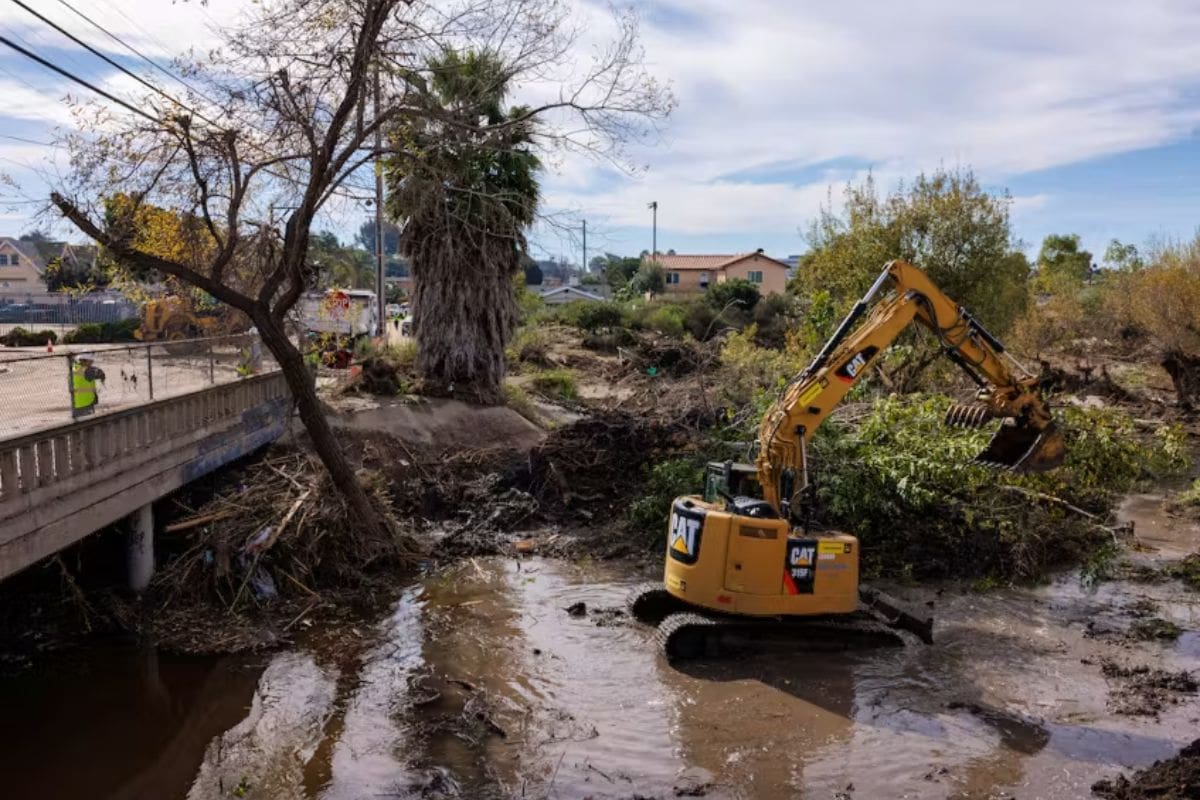California Faces Back-To-Back Atmospheric: As winter settles in, California finds itself bracing for the impact of not one, but two consecutive atmospheric rivers that are poised to drench the state. These formidable weather systems, characterized by long, narrow bands of moisture-laden air, originate over the Pacific Ocean and unleash torrential rain and snow over vast regions.
With the first atmospheric river making its way from the Pacific Northwest towards Southern California, the state is preparing for potential challenges and consequences. From infrastructure strain to environmental impacts, the arrival of these atmospheric rivers raises important questions about our changing climate and the role of human influence.
In the face of such uncertainty, California finds itself at the mercy of nature’s unpredictable power.
Key Takeaways
- Residents and authorities in California are intensifying preparations for winter storms, including working with emergency management agencies and developing evacuation plans.
- The progression of the storm from the Pacific Northwest to Southern California involves heavy rainfall and gusty winds, prompting flood watches and high-wind warnings.
- Southern California faces the risk of stronger winds, heavier rainfall, and potential flooding, leading to increased alertness and stocking up on emergency supplies.
- The environmental impacts of the storms include positive consequences such as improved water supply and replenished reservoirs, but also negative consequences like flooding, landslides, and infrastructure damage.
California Prepares for Winter Storms
As California braces itself for a series of powerful winter storms, known as the ‘Pineapple Express,’ the state’s residents and authorities are intensifying their preparations to mitigate potential impacts and ensure community safety.
The ‘Pineapple Express’ storms are characterized by an atmospheric river, a narrow band of concentrated moisture that originates from warm subtropical waters near Hawaii. These storms mark a shift from the record warmth experienced in late January and are expected to bring heavy rainfall, strong winds, and the possibility of flooding and mudslides.
Climate scientist Daniel Swain emphasizes the significance of these storms, noting their potential impact on the region. In response, California’s emergency management agencies are working closely with local authorities to implement evacuation plans, reinforce infrastructure, and provide resources to residents.
The state is also urging residents to stay informed, have emergency kits prepared, and heed evacuation orders if necessary.
Storm’s Progression: From Pacific Northwest to Southern California
The storm’s progression from the Pacific Northwest to Southern California is marked by heavy rainfall and gusty winds, creating a sense of urgency as residents in both regions actively prepare for its arrival.
| Region | Impact | Preparations |
|---|---|---|
| Pacific Northwest | Rain and gusty winds | Residents prepare for heavy rainfall and winds |
| Northern California | Rain and gusty winds | Sandbags and cleared storm drains |
| San Francisco Bay area | Flood watches and high-wind warnings | Active preparations by residents |
| California’s Central Coast | Flood watches and high-wind warnings | Residents on high alert for potential impacts |
The initial storm hits the Pacific Northwest, bringing rain and gusty winds south into Northern California and the San Francisco Bay area. As it intensifies, residents in Southern California, still recovering from recent flooding, actively prepare with sandbags and cleared storm drains. The National Weather Service issues flood watches and high-wind warnings for the Bay area and California’s Central Coast. As the storm progresses, residents in all regions remain on high alert, ready to respond to potential impacts.

ALSO READ: Level 3 Storm Flood Watch in Place as Heavy Rain Forecasted on Wednesday
Impacts on Southern California: Challenges and Preparations
Following the storm’s progression from the Pacific Northwest to Southern California, the impacts on the region are now shifting focus to the challenges and preparations faced by Southern California residents. With a second, potentially more powerful storm approaching on Sunday, there are concerns about stronger winds and heavier rainfall.
Daniel Swain, a climate scientist, notes the uncertainty but emphasizes the risk of sustained rainfall and flooding. As the state already grapples with record-breaking rains and flash flooding, residents are bracing themselves for the potential challenges ahead. However, despite these concerns, the precipitation is seen as beneficial for the state’s water supply.
Southern California residents are taking necessary precautions and making preparations to mitigate the potential impacts of the upcoming storms. Some of these preparations include:
- Stocking up on emergency supplies such as food, water, and batteries.
- Clearing gutters and drains to prevent flooding.
- Staying informed and following updates from local authorities and weather forecasts.
Environmental Impact: Positive and Negative Consequences
Amidst the challenges posed by the back-to-back atmospheric rivers, California is poised to experience a range of environmental impacts with both positive and negative consequences. The anticipated rainfall from the storms could bring some much-needed relief to California’s water supply. It has the potential to improve mountain snowpacks, which are currently below-average levels.
This could help replenish reservoirs and groundwater, addressing the state’s ongoing water scarcity issues. However, the excessive precipitation also carries risks. The heavy rainfall can lead to flooding and landslides, causing damage to infrastructure and posing a threat to human safety. The delicate balance between the advantages of precipitation and the risks of extreme weather events highlights the vulnerabilities of California’s infrastructure, as demonstrated in previous atmospheric river storms.
| Positive Consequences | Negative Consequences |
|---|---|
| Improved water supply | Flooding |
| Replenished reservoirs | Landslides |
| Addressing water scarcity | Infrastructure damage |
| Snowpack improvement | Human safety risks |
| Potential for groundwater recharge |

Climate Change and Future Outlook: The Role of Human Influence
As California prepares for the back-to-back atmospheric rivers, it is essential to consider the role of human influence in the changing climate and future outlook of the region.
Climate change, primarily driven by human activities, has been identified as a significant factor contributing to the increase in the frequency and intensity of these storms.
Here are three key points to understand the role of human influence:
- Greenhouse gas emissions: The release of carbon dioxide and other greenhouse gases from burning fossil fuels has led to a warming atmosphere, which in turn affects weather patterns and increases the likelihood of extreme events like atmospheric rivers.
- El Niño: While El Niño is a natural weather phenomenon, human-induced climate change can exacerbate its effects, leading to more intense and frequent atmospheric rivers.
- Adaptation and resilience: As California faces the challenges of changing climate patterns, it is crucial to prioritize preparedness and resilience measures to mitigate the impacts of these storms and ensure the safety and well-being of communities.
Considering the role of human influence in the changing climate and future outlook is vital for effective planning and response strategies in California.
Conclusion Of California Faces Back-To-Back Atmospheric
California is bracing itself for the arrival of back-to-back atmospheric rivers, which are expected to bring significant rainfall to the state.
These winter storms pose both challenges and opportunities for Southern California, as they can lead to flooding and landslides while also replenishing water supplies and benefiting the environment.
The impacts of climate change on these atmospheric rivers highlight the need for continued efforts to mitigate human influence on the climate system.

